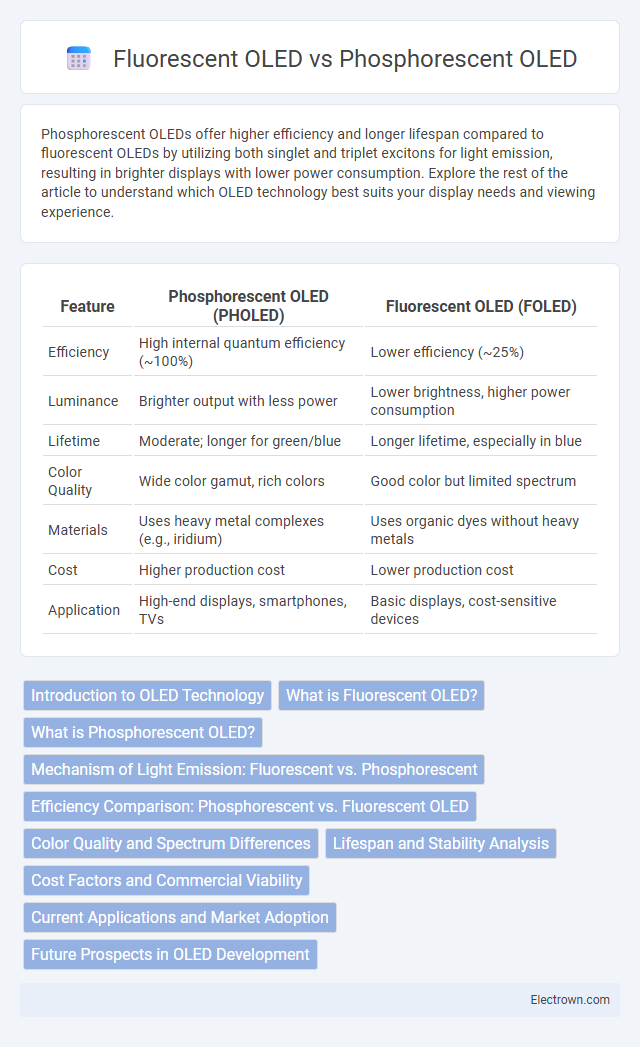Phosphorescent OLEDs offer higher efficiency and longer lifespan compared to fluorescent OLEDs by utilizing both singlet and triplet excitons for light emission, resulting in brighter displays with lower power consumption. Explore the rest of the article to understand which OLED technology best suits your display needs and viewing experience.
Table of Comparison
| Feature | Phosphorescent OLED (PHOLED) | Fluorescent OLED (FOLED) |
|---|---|---|
| Efficiency | High internal quantum efficiency (~100%) | Lower efficiency (~25%) |
| Luminance | Brighter output with less power | Lower brightness, higher power consumption |
| Lifetime | Moderate; longer for green/blue | Longer lifetime, especially in blue |
| Color Quality | Wide color gamut, rich colors | Good color but limited spectrum |
| Materials | Uses heavy metal complexes (e.g., iridium) | Uses organic dyes without heavy metals |
| Cost | Higher production cost | Lower production cost |
| Application | High-end displays, smartphones, TVs | Basic displays, cost-sensitive devices |
Introduction to OLED Technology
Phosphorescent OLEDs utilize triplet excitons to achieve higher internal quantum efficiency, making them significantly more energy-efficient compared to Fluorescent OLEDs, which rely on singlet excitons and have limited efficiency. The advanced molecular design in Phosphorescent OLEDs allows for brighter displays and longer device lifespans, enhancing your overall viewing experience. Understanding these differences highlights the technological evolution within OLED devices and their impact on modern display performance.
What is Fluorescent OLED?
Fluorescent OLEDs utilize fluorescent materials to emit light through the process of singlet exciton recombination, resulting in lower efficiency compared to phosphorescent OLEDs. These devices typically exhibit shorter lifespan and reduced brightness due to their inability to harness triplet excitons for light emission. Fluorescent OLEDs are commonly used in commercial displays where cost-effectiveness and simpler fabrication methods are prioritized over maximum efficiency.
What is Phosphorescent OLED?
Phosphorescent OLED (PHOLED) is a type of organic light-emitting diode that utilizes phosphorescent materials to achieve higher internal quantum efficiency by harvesting both singlet and triplet excitons. This technology enables PHOLEDs to reach efficiency levels up to 100%, significantly surpassing fluorescent OLEDs which only use singlet excitons with around 25% efficiency. The enhanced energy utilization in phosphorescent OLEDs results in brighter displays and longer device lifespans, making them superior for high-performance lighting and display applications.
Mechanism of Light Emission: Fluorescent vs. Phosphorescent
Phosphorescent OLEDs utilize triplet excitons for light emission by harnessing spin-orbit coupling to convert non-radiative triplet states into radiative excited states, resulting in higher internal quantum efficiency, often approaching 100%. Fluorescent OLEDs rely solely on singlet excitons for light production, where only about 25% of the excitons contribute to emission due to spin statistics limiting radiative recombination. This fundamental difference in exciton utilization explains why phosphorescent OLEDs exhibit superior brightness and energy efficiency compared to their fluorescent counterparts.
Efficiency Comparison: Phosphorescent vs. Fluorescent OLED
Phosphorescent OLEDs achieve higher efficiency by utilizing both singlet and triplet excitons for light emission, reaching internal quantum efficiencies close to 100%, whereas Fluorescent OLEDs only use singlet excitons with efficiencies around 25%. The delayed emission process in Phosphorescent OLEDs allows for better energy harvesting and longer device lifetimes under comparable operating conditions. Despite their efficiency advantage, Phosphorescent OLEDs often require more complex and expensive materials such as heavy metal complexes like iridium or platinum.
Color Quality and Spectrum Differences
Phosphorescent OLEDs deliver superior color quality with higher efficiency by utilizing triplet excitons, producing richer and more vibrant colors compared to Fluorescent OLEDs, which rely solely on singlet excitons and exhibit a narrower color spectrum. Your display will benefit from phosphorescent technology's broader emission spectrum, enabling deeper blacks and more accurate color reproduction across the visible range. This results in enhanced visual performance, especially for applications demanding vivid imagery and consistent color fidelity.
Lifespan and Stability Analysis
Phosphorescent OLEDs exhibit significantly longer lifespans and enhanced stability compared to fluorescent OLEDs due to their ability to harvest both singlet and triplet excitons, resulting in higher internal quantum efficiency. Fluorescent OLEDs typically suffer from lower operational stability and shorter device lifetimes because they utilize only singlet excitons, leading to increased degradation under prolonged electrical stress. Research indicates phosphorescent materials can achieve operational lifetimes exceeding 10,000 hours, while fluorescent counterparts often fall below 5,000 hours, highlighting the superiority of phosphorescent OLEDs for durable display and lighting applications.
Cost Factors and Commercial Viability
Phosphorescent OLEDs (PHOLEDs) offer higher energy efficiency by utilizing both singlet and triplet excitons, reducing power consumption and extending device lifespan compared to fluorescent OLEDs, which only harness singlet excitons. Despite the higher material costs and complex manufacturing processes of PHOLEDs, their superior performance results in better commercial viability for high-end displays and lighting applications. Your choice of OLED technology should weigh initial production expenses against long-term operational savings and market demand for vibrant, durable screens.
Current Applications and Market Adoption
Phosphorescent OLEDs dominate the market with superior energy efficiency and longer lifespan, making them ideal for high-end smartphones, TVs, and wearable displays where vibrant colors and brightness are critical. Fluorescent OLEDs, while offering faster response times and lower production costs, are primarily found in niche applications such as monochromatic displays and certain industrial devices. Your choice depends on whether energy efficiency and vivid color quality or cost-effectiveness and specific performance factors are the priority in your display technology needs.
Future Prospects in OLED Development
Phosphorescent OLEDs (PHOLEDs) exhibit higher internal quantum efficiency, reaching up to 100%, which positions them as the leading technology for future display and lighting solutions. Fluorescent OLEDs, limited by their 25% efficiency ceiling due to singlet exciton utilization, face challenges in achieving comparable performance. Innovations in PHOLED materials and structures continue to drive advances in device longevity, color purity, and energy efficiency, marking phosphorescent OLEDs as the cornerstone of next-generation OLED development.
Phosphorescent OLED vs Fluorescent OLED Infographic

 electrown.com
electrown.com